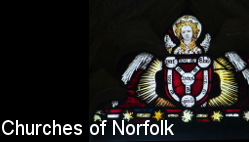
home I index I latest I glossary I introductions I e-mail I about this site
All Saints, Stanford
Follow these journeys as they happen on X/twitter.
All Saints, Stanford All Saints is one of
the four churches of
the Norfolk Battle Training Area and is not
generally accessible by the public. Indeed Stanford's former parish church is at the
very heart of the training area, the live firing zone,
and it is so far from civilisation that the silence in
the air is remarkable. I recall the first time I ever
came here about twenty years ago. I had not heard such a
silence in England before. The sheep were fearless,
inquisitive as we let ourselves into the churchyard, but
their lambs hid behind them, chins tilted upwards as they
watched. As I wandered about the churchyard, tiny spring
rabbits bolted from beneath my feet. At first this was
startling, and then comical, for they had never seen a
human before, and they waited until I was right on top of
them before running for the scrub. I became wary lest I
step on one, but I don't think they were ever in any real
danger. You step into a wide,
almost square space, beyond which the chancel seems
almost an afterthought. Since my previous visit, the east
end of the nave has been filled with scaffolding,
apparently to support the chancel arch and roof. The
small octagonal font tucked in the south-west corner
could be any age, but is probably late 14th Century I
expect. Sutton's restoration brought the chancel murals,
the raised steps, the great rood, and even the painted
glass in the north aisle window, which Pevsner thought
worthy of mention, but which is mostly now lost. There is
more of Sutton's work at West Tofts, and also at Brant
Broughton in Lincolnshire, the main family seat,
including much glass made by him and his brother
Augustus. The arcades rest on elegant, fluted columns,
and something very odd has happened at the east end of
the south aisle, where a former archway appears to have
been truncated by the eastern wall. Did it lead into a
former south transept? Or was it begun and never
finished? Curious. Simon Knott, December 2023 Follow these journeys as they happen on X/twitter. a general introduction to the churches of the Norfolk battle training area |
|
||||||||||||||||||||||||||||||||||||||||||||||||||||||
home I index I latest I introductions I e-mail I about
this site I glossary
Norwich I ruined churches I desktop backgrounds I round tower churches
links I small
print I www.simonknott.co.uk I www.suffolkchurches.co.uk